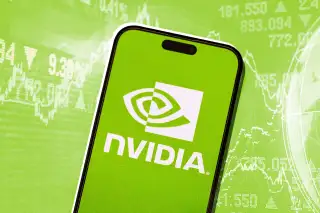Nvidia Just Became the First Company Worth $4 Trillion. Here's How to Invest

On Wednesday, Nvidia (NVDA) became the first publicly traded company to achieve a $4 trillion market capitalization, just 24 trading days after joining the $3 trillion club in June, alongside Apple (AAPL) and Microsoft (MSFT).
The surge in valuation for the leader of the semiconductor industry has mirrored the explosive adoption of AI — a technology that is highly reliant upon Nvidia's products. Nvidia's chips, graphics cards and software, which are designed to both train and operate AI programs, are integral to other Magnificent Seven companies' AI ambitions. Among Nvidia's clientele are Alphabet (GOOGL), Amazon (AMZN), Meta Platforms (META), Microsoft and Tesla (TSLA).
As demand for its products has skyrocketed, so too have its shares. Five years ago, NVDA was trading for $10.48. At press time, the stock is trading for $162.98, or 1,455.15% higher than in July 2020. So far this year, NVDA is up 17.80%, outpacing the S&P 500's year-to-date gain of 6.40%.
NVDA stock outlook remains bullish
Despite those enormous gains, Wall Street analysts remain bullish on the market's AI darling. Nvidia receives a consensus "Strong Buy" rating from the 40 analysts covering the stock, with 35 assigning it a "Buy" rating, four assigning it a "Hold" rating and just one assigning it a "Sell" rating.
Of course, Wall Street doesn't have a crystal ball. Nor does AI, for that matter. While Nvidia's outlook remains strong, it isn't impervious to volatility. From its then-year-to-date high on Jan. 6 through its year-to-date, or YTD, low on April 4, the stock lost nearly 37%. Since that YTD low, the stock is up 72.75%.
Nonetheless, forecasts for Nvidia remain optimistic, with the Wall Street Journal pinning a median, 12-month price target at $175, or 7.41% higher than where shares of NVDA are trading today.
How to gain exposure
Retail investors can follow institutional investors' footsteps and own the stock. More than 65% of the company's outstanding shares are held by institutions, including 2.2 billion shares by Vanguard, 1.9 billion by BlackRock and 1.0 billion by Fidelity Investments.
A safer way to gain exposure to the chipmaker is via weighted index funds. As the S&P 500's largest company by market cap, Nvidia has a dominant weighting in a handful of broad-based, lower-risk exchange-traded funds, or ETFs, that carry reasonable expense ratios.
For instance, the Vanguard S&P 500 ETF (VOO) — the world's largest ETF by assets under management, or AUM, with $688 billion — currently has NVDA as its second-largest holding, weighted at 6.60% (MSFT is its largest at 6.83%). The SPDR S&P 500 ETF Trust (SPY) — the second-largest ETF with $637 billion in AUM — features NVDA as its largest holding with a weighting of 7.40%.
Similarly, tech-focused ETFs allow investors to gain exposure to Nvidia without having to own shares of the company directly. NVDA accounts for 9.25% of the total portfolio of the Invesco NASDAQ 100 ETF (QQQM), for example.
An additional bonus of using ETFs to gain exposure to NVDA is that they often pay dividends with higher yields than the tech giants provide themselves. The three aforementioned funds currently yield 1.22%, 1.16% and 0.55%, respectively, all of which surpass Nvidia's 0.02% dividend yield.
More from Money:
We Asked AI Which Stocks to Buy in July. Here's What It Said
What Financial Advisors Are Telling America's Richest People to Do With Their Money
Follow the Money? Here Are the Stocks Hedge Funds Bought and Sold in the First Quarter